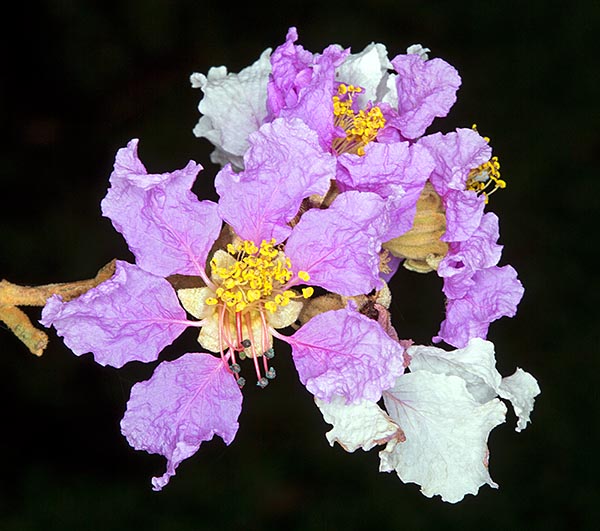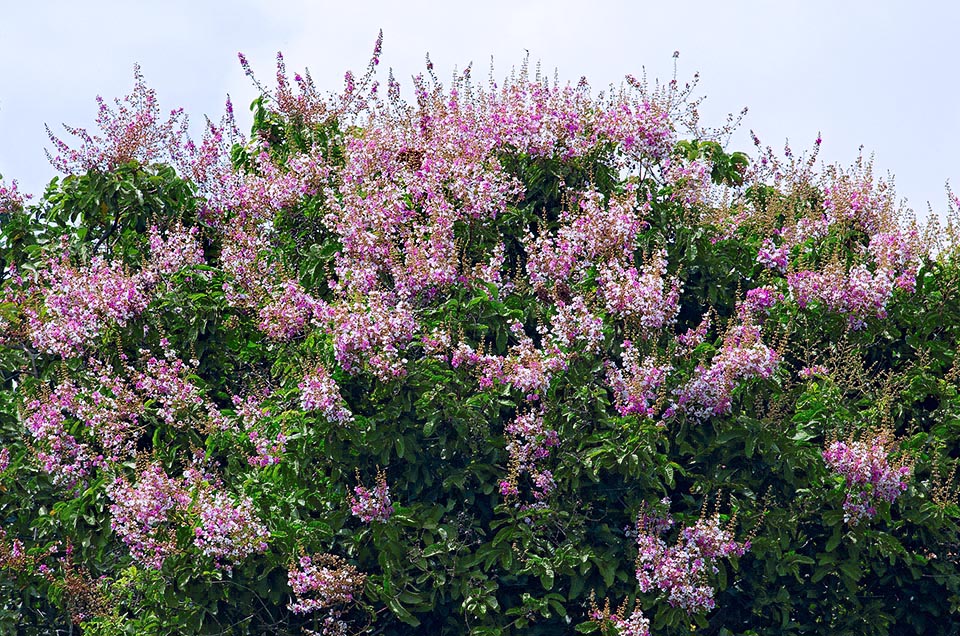Family : Lythraceae

Text © Pietro Puccio

English translation by Mario Beltramini

Lagerstroemia floribunda has 2-3 cm flowers with mauve unguiculate petals turning white with the time © Giuseppe Mazza
The genus was honoured by Linnaeus to his friend Magnus Lagerström (1691-1759) who was director of the Swedish East India Company; the specific name is the Latin adjective “floribundus, a, um” = floriferous, that bears many flowers, from the verb “floreo” = to flourish.
Common names: Thai crape myrtle, tropical crape myrtle (English); kamaung-phyu (Burmese); trapek (Khmer); líng guǒ zǐwēi, dà huā zǐwēi (Chinese); kedah bungor (Malaysian); tabaek-na (Thai); bằng lăng nhiều hoa (Vietnamese).
The Lagerstroemia floribunda Jack (1820) is an evergreen or semi-deciduous tree with a dense canopy, usually 10-15 m tall, but that in the old specimens in the wild can reach the height of 30 m, with trunk up to 60 cm of diameter, grooved at the base, and rather smooth bark of grey-brown colour tending to flake off. The leaves, on short petiole, are opposite or sub-opposite, simple, oblong to oblong-ovate with pointed apex, entire margin and prominent veins, 10-25 cm long and 5-10 cm broad, initially of intense bronze colour and tomentose in the lower page, then intense green and glossy in the upper page. Terminal panicle inflorescences, up to about 50 cm long, very ramified and bearing numerous hermaphroditic flowers, of 2-3 cm of diameter, with 6 unguiculate petals (petals with the long narrow base similar to a stem) with ovate edge having wavy margins, of pink mauve colour gradually tending to white, and numerous stamina with yellow anthers; peduncle, pedicels and calyx are covered by a rust coloured tomentum. The fruits are dehiscent woody capsules, oblong, 1-1,6 cm long containing several winged dark brown seeds.
It easily reproduces by seed, previously kept in water for 1-2 days, placed superficially in draining organic loam maintained humid at the temperature of 25-28 °C, with variable germination times, from two weeks to two or more months, but also by cutting and air layering.
Species of great ornamental and landscaping value thanks to the abundant blooming in spring-summer, frequently utilized, especially in south-eastern Asia, in parks and gardens and as road tree.

In the humid forests of Cambodia, Thailand, Malaysia and Vietnam reaches the 30 m of height. Spectacular inflorescences, prized wood and medicinal virtues © G. Mazza
The wood, of red brown colour, with good characteristics of hardness, resistance to termites and easy to work, is utilized for interior parts, being not too resistant to the atmospheric agents, in the civil constructions, for floors, partitions and frames, in the naval furnishing and for quality furniture.
Parts of the plant are utilized in the traditional medicine, in particular with the crushed leaves they prepare cataplasmes in cases of high fever. Laboratory studies have shown a high antimicrobial activity of the flowers extracts, in particular against Propionibacterium acnes (Gilchrist 1900) Douglas & Gunter 1946, responsible for some pathologies of the skin such as acne.
Synonyms: Murtughas floribunda Kuntze (1891).
→ To appreciate the biodiversity within LYTHRACEAE family please click here.
